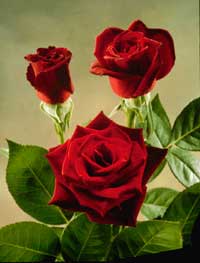 |
Roses are among the oldest cultivated flowers known to humankind. Designated the official flower of the United States in 1986, they have always been the aristocrat of flowers.
Modern roses are hybrids developed from two or more of several Asian rose species. They are generally classified by form--
Bush Rose or Hybrid Tea Rose
Shrub Rose or Landscape Rose
Miniature Rose
Climbing Rose
Each type of rose plant has characteristics that suit it for specific landscape use in a residential yard and garden.
Thoughts On Choosing The Right Rose
Notes From Nancy
One of the secrets to growing roses is choosing the right plants.
Far too many gardeners have their heads turned by a pretty bloom only to find the romance turns sour when the leaves of the rose bush turn ugly, peppered with black spot or covered with powdery mildew. Even worse, many roses fail to thrive after a year or two.
Good disease-resistance and cold-hardiness are big issues for me because I don't use chemicals, and mounding soil and mulch around the base of the plants in late fall is my limit when it comes to winter protection.
I want roses to look good in my garden, blooming from June through frost, so I look for blossoms that are not only beautiful in bloom, but age well.
To keep the garden looking tidy, white and lighter-color blossoms in shades of pink, yellow and cream must be deadheaded when spent or they quickly turn an unattractive shade of brown. Deeper-colored flowers such as red and vibrant pinks darken as they age and become less visible when they dry, making deadheading less of an issue.
One of the first things I look for are roses grown on their own roots because they survive extreme temperatures better than grafted roses. The suckers that emerge soon become blooming stems, increasing the size of the plant.
"Sunrise Sunset," which is grown on its own root, is a new introduction from Easy Elegance. It sports clusters of bright fuchsia flowers that magically turn apricot near the center as they open.
Rose expert Nancy Lindley, co-owner of Great Lakes Roses, and author of "Roses for Michigan" ($18.95, Lone Pine Press) includes these roses at the top of her list.
The Explorer roses developed by Agriculture Canada are renowned for their hardiness as well as appearances. From this large collection, Lindley selected the 5- to 6-foot red blend "Alexander MacKenzie." The stunning and fragrant medium-pink, double-bloom "Aunt Honey" rose introduced by Dr. Grifith Buck in 1985 remains one of her favorites.
Rugosa roses are the hardiest of the lot and the fragrant, dark-mauve hybrid "Wildberry Breeze" is another of Lindley's hot picks.
One of my favorites is "Lovely Fairy" from Heirloom Roses. This bush spends the entire summer and fall frosted with an outstanding display of clusters of tiny bright pink roses.

